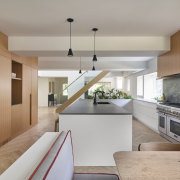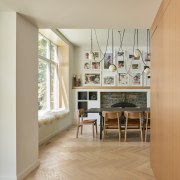Slice of life
Taking a double height slice out of the existing home allowed for a light, open, more approachable interior for this comprehensive makeover
Designed by Batay-Csorba Architects
From the architects:
This home renovation/addition project consists of structural renewal and re-organisation with an opening up of the existing layout, and the addition of a kitchen and master bedroom suite.
The context
The wider area – under study as a heritage conservation district in Toronto – was developed as garden suburb in 1912 by developer Robert Home Smith and was marketed as "a bit of England far from England".
This period was marked by a fascination with Medieval Revival, and the Arts and Crafts movement, so many of the initial homes built in the neighbourhood were in the English Cottage or Tudor Revival style.
Robert Home Smith had strict rules about the standards of the neighbourhood, where the plans of every new home needed to be approved by his architects. His development ensured the natural topography of the land was maintained to create picturesque settings for each home. Also, with each house sold, the purchaser had to sign an agreement that the integrity of the designs would remain intact for 30 years.
Now, 100 years passed, the purchaser agreements have been lifted and the heritage status of the neighbourhood is still under study.
Arts and Crafts movement
The owners of this residence had an interest in the Arts and Crafts movement, and preserving neighbourhood character, so the architects worked to understand the underlying principles of the movement.
Beyond Medieval motifs, ornamentation, and a nostalgia for handcraftsmanship, they also interpreted the Arts and Crafts movement spatially.
The architects understood it to be about creation of immersive and enveloping spaces through rich, warm materials and tones and the overall sense of weight; also, organisation of an open floor plan into intimate sub-spaces, each organised around a specific activity and articulated through furniture built into a thickened wall.
Most of the house’s original exterior of stucco and stones from the local Humber river has been kept intact.
The architects focused on opening views to a back ravine by cutting a large double height slice in the west side of the home, adding an additional peak to the back façade.
Let there be light
The interior of the home was originally subdivided into small rooms, and by slicing through the home they opened all floors, letting light flood through the space.
The main floor is now centred around a built-in storage piece, which acts as a heavy mass in an open plan.
On the kitchen side it provides a pantry, fridge and a coffee bar; and a bar nook on the dining side.
All the windows are thickened and clad in wood to create opportunities for comfy seating, and different zones are created in the floor plan through a thickening of the bulkheads.
Custom furniture in the house was built by local designer Heidi Earnshaw.
Since her practice focuses on re-imagining historical types of craftsmanship in a contemporary context, furniture such as the breakfast banquette helped to create the warmth and the attention to detail reminiscent of the Arts and Crafts aesthetic.
Home kitchen bathroom commercial design
Classic looks, contemporary efficiency
Diving into nature
Personality plus
Trends 37-04
There’s a variety of design creativity to inspire in this edition. A curvaceous seaside home features a pool with a diff...
Read More
















